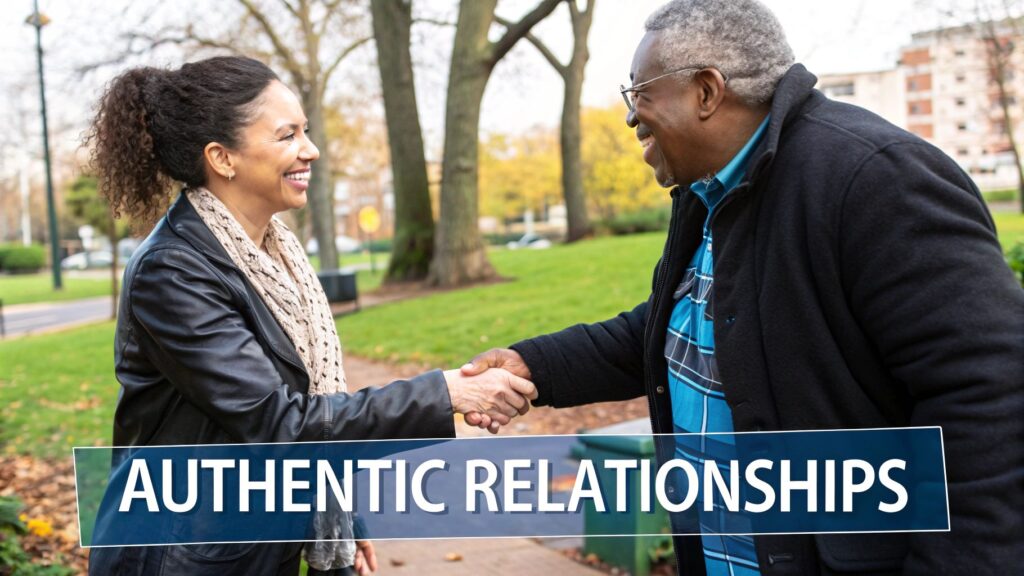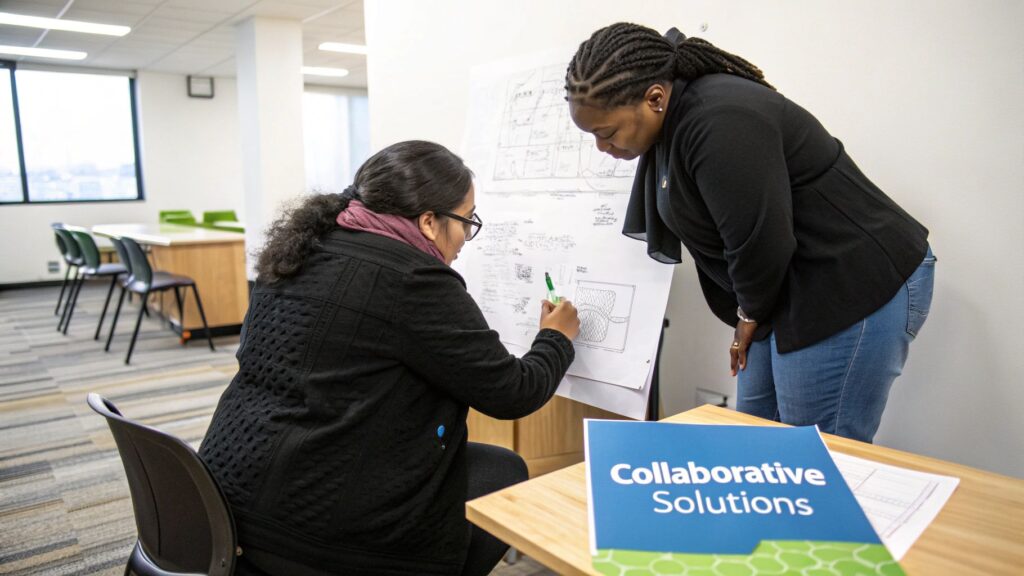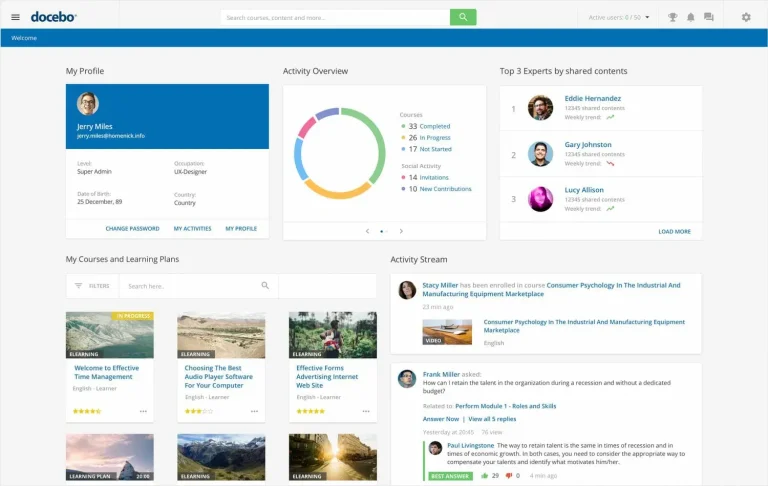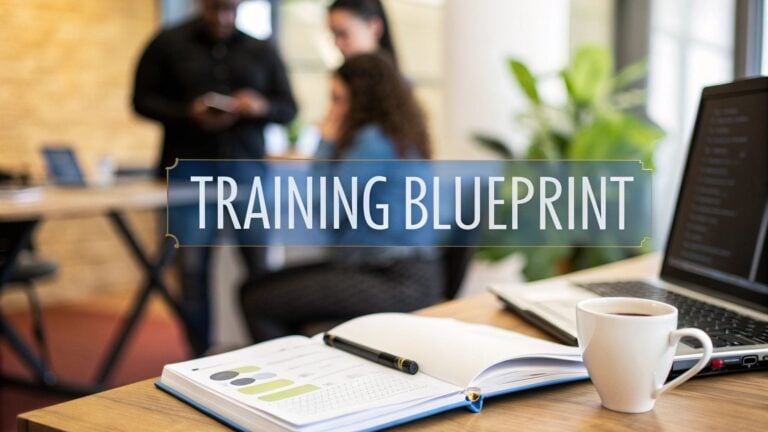8 Community Engagement Best Practices for 2025

I’ve seen it before.
An online course creator or membership owner builds an amazing product, but the community forum is a ghost town. It’s a common problem. You put all that work into creating a space for connection, only to hear crickets.
The good news is that building an active community isn’t about luck. It’s about strategy. A great community becomes the heart of your members’ experience. It boosts how long they stick around and turns quiet learners into huge fans. It all comes down to a few key ideas that help people connect for real.
Think of it this way: people don’t just want content, they want connection. They want to feel seen, heard, and valued. When you give them that, engagement just happens.
This article is your roadmap. We’ll skip the fuzzy theories and get straight into eight powerful community engagement best practices that work.
These are real steps you can use right away to turn your quiet forum into a busy hub of activity. We’ll cover everything from listening well and building real relationships to making sure everyone can join in and creating solutions with your members.
1. Active Listening and Two-Way Communication
Real community engagement starts with listening. This is a basic practice that goes beyond just posting announcements or content. Active listening means you hear your members’ ideas, feedback, and worries. Then, you create a real conversation around them.
This two-way street is what turns a quiet audience into an active community where people feel seen, heard, and valued. When members know their input can actually shape the community, their sense of ownership and loyalty grows a lot.
This approach is one of the strongest community engagement best practices because it builds trust. When you consistently show you’re using feedback to make the experience better, you create a powerful positive cycle.
Real-World Examples of Success
Big brands have built entire platforms around this idea.
LEGO Ideas: This great platform lets fans submit their own designs for new LEGO sets. If a design gets 10,000 votes, it goes into a formal review process by LEGO. Several of these fan-made designs, like the Women of NASA and The Beatles’ Yellow Submarine sets, have become official, best-selling products. LEGO listened to its biggest fans and made their ideas real.
My Starbucks Idea: For years, Starbucks had a platform where customers could submit and vote on suggestions. It led to popular new things like mobile payments, free Wi-Fi, and new drink flavors. This showed customers that their daily ideas mattered to a huge company.
How to Implement Active Listening
Here are some real steps to build a culture of two-way communication in your online community:
Create Clear Feedback Loops: Don’t let suggestions just disappear. If you use a member’s idea, announce it! Publicly thank the person who suggested it and explain how their feedback led to the change. This shows everyone you are listening and taking action.
Use Multiple Channels: People communicate in different ways. Offer a few options for members to share their thoughts. This could be dedicated forum threads, regular surveys, suggestion boxes, live Q&A sessions, or even direct messages with community managers.
Set Response Timelines: Let people know how quickly your team will reply to feedback. Even a simple, “Thanks for this suggestion, we’re looking into it and will have an update by Friday,” builds a lot of trust and manages expectations.
Train Your Team: Make sure your community managers and moderators are good at active listening, empathy, and handling disagreements. They are your front line, and how they handle conversations is super important.
2. Authentic Relationship Building
Good engagement is built on real, long-term relationships. This means you develop connections with community members based on trust, respect, and shared values.
You have to show up consistently and prove you are committed beyond just making a sale. When members feel a real connection to the people running the community, they turn from customers into fans.

This method is one of the most important community engagement best practices because it creates deep loyalty. By showing you care about your members and what they value, you create a strong and supportive group that can handle challenges and grow naturally.
Real-World Examples of Success
This approach has been a key for many brands with a strong mission.
Patagonia: The outdoor clothing company builds real relationships by working with local environmental groups. They don’t just write checks. They actively support local activists, fund documentaries, and get their customers involved in environmental causes. This shared mission creates an incredibly strong bond with their community.
Ben & Jerry’s: The ice cream brand has a long history of working with social justice groups. They build their values right into their business, from how they name products to where they get ingredients. This consistency shows their community that their activism is real, not just a marketing trick, which builds a lot of trust.
How to Implement Authentic Relationship Building
Here are some real steps to build genuine connections in your online community:
Be Consistently Present: Show up regularly, not just when you’re launching something or need help. Join discussions, answer questions, and be a visible, helpful person. Being consistent over time proves you’re committed.
Celebrate Member Achievements: Publicly recognize and celebrate your members’ wins, even when they’re not directly about your work. Acknowledging a member’s personal or professional success shows you see them as a whole person, not just a user.
Invest in Understanding Your Members: Take time to learn about your community’s shared interests, problems, and culture. Use what you learn to create content and experiences that are helpful and valuable to them.
Empower Member Leaders: Find passionate members and give them chances to take on leadership roles, like moderating a forum or hosting a small group chat. This shows trust and lets them help build the community with you.
3. Inclusive and Accessible Participation
An engaged community is one where every single member has the chance to participate. Inclusive and accessible participation is about designing your community spaces and activities to remove barriers.
This makes sure that different voices, especially from people in underrepresented groups, can be heard and valued. It’s a practice that ensures opportunities are open to everyone, no matter their background, ability, or situation.

This mindset is one of the most critical community engagement best practices you can use. When people see you are making a real effort to include them, it builds a deep sense of belonging and safety. These are key for members to share their best ideas and feel connected.
Real-World Examples of Success
This approach is used by social justice movements and large organizations.
Microsoft: The tech giant has made accessibility a core part of its product development. Its user research and community feedback programs actively look for people with disabilities. This ensures products like Windows and Office are built with their needs in mind from the start. This has led to amazing accessibility features that help all users.
City of Seattle: When Seattle started its participatory budgeting process, it made a big effort to include non-English speaking communities. They provided all materials and held meetings in multiple languages, including Vietnamese, Spanish, and Somali. This allowed a much wider range of residents to help decide how to spend public money.
How to Implement Inclusive Participation
Here are some real steps to make your community more inclusive and accessible:
Conduct Accessibility Audits: Regularly check your community platform, content, and engagement activities. Is your website accessible to screen readers? Do your videos have captions? Are your virtual events, like webinars, designed for different kinds of participation? This can make a huge difference. For more ideas, you can explore proven techniques for webinar engagement.
Offer Multiple Ways to Participate: Understand that members have different comfort levels and abilities. Provide different ways for them to give input, like forum discussions, anonymous surveys, live video calls, and one-on-one messages. This respects different communication styles and schedules.
Partner with Relevant Organizations: Connect with groups that serve underrepresented communities you want to engage. They can give you valuable insights and help you build real relationships based on trust and respect.
Compensate Members for Their Time: When you ask for a lot of input or expertise, think about offering compensation. This could be a membership discount, gift cards, or a direct payment. It shows you value their contribution.
4. Transparent and Accountable Processes
Trust is the currency of any strong community, and nothing builds trust faster than being transparent.
Being open about how decisions are made, how resources are used, and what results are achieved shows respect for your members. It goes beyond just asking for input and shows you are committed to being accountable. This means clearly showing how community feedback actually influences final decisions and being upfront about the whole process.

This practice is one of the most important community engagement best practices because it answers the “what happened next?” question.
When members see the direct line from their contribution to a community result, they feel powerful and are more likely to stay engaged. This transparency applies to both successes and failures.
Real-World Examples of Success
This level of openness is a powerful tool for businesses and online platforms too.
Buffer: The social media management company is famous for its radical transparency. Buffer publicly shares everything from employee salaries and company revenue to its product roadmap. This openness reaches their community, where they are honest about challenges and how they make decisions. This builds incredible loyalty and trust among their users.
Wikipedia: The entire model of Wikipedia is built on transparent processes. Every edit is tracked in a public history, and big content decisions are debated openly on “talk” pages. Anyone can see who made a change and why. This creates a system where accountability is built right into the community’s foundation.
How to Implement Transparent Processes
Here are some practical steps to build transparency and accountability in your online community:
Create Standardized Reports: Make simple, easy-to-read templates for community updates. Use these to regularly report on key numbers, progress toward goals, and how member feedback has been used. A consistent format makes the information easy to follow.
Use Plain Language: Avoid jargon and corporate talk. Communicate in a clear, straightforward way that is easy for everyone in your community to understand, no matter their background.
Establish a Communication Schedule: Set a regular schedule for your updates. This could be a monthly “State of the Community” post or a bi-weekly “You Asked, We Answered” video. Sticking to this schedule builds reliability and shows your commitment.
Be Proactive with All News: Don’t wait for members to find problems on their own. Be the first to share news, good or bad. Tackling challenges head-on, explaining what happened, and outlining your plan to fix it is a powerful way to build trust.
5. Asset-Based Community Development (ABCD)
Instead of focusing on what’s missing, Asset-Based Community Development (ABCD) flips the script.
This strategy is one of the most sustainable community engagement best practices because it builds collective power. When members see their own skills and contributions as the main building blocks of the community’s value, they develop a deep sense of pride and shared ownership. It creates a strong, self-sufficient group that doesn’t just depend on the community manager to create value.
Real-World Examples of Success
This “strengths-first” mindset has worked in many places, from city neighborhoods to online groups.
Detroit’s Urban Farming Initiatives: Facing money problems, residents in Detroit didn’t wait for outside help. They identified their existing assets: farming knowledge passed down for generations and empty city lots. By combining these, they created successful urban farms and community gardens. These now provide fresh food, build local economies, and strengthen neighborhoods.
The Asset-Based Community Development Institute (ABCD Institute): Founded by John McKnight and John Kretzmann, the institute works with communities all over the world. They do great work with rural towns, helping them map local assets like craft skills, cultural sites, and natural resources to start new economic and social development from within.
How to Implement Asset-Based Community Development
Here are some practical steps to use the ABCD model in your online learning community:
Start with Strengths-Based Conversations: Frame your questions around what’s working. Instead of asking “What problems are you having?”, try asking “What was your biggest win this week?” or “Share a skill you’re proud of that could help another member.”
Map Your Community’s Assets: Create a visual or written “map” of your community’s resources. This includes members’ professional skills, hobbies, personal experiences, and even the tools or software they can use. You can do this with surveys, profile fields, or special forum threads.
Connect the Dots: Act as a facilitator. Once you know that one member is a graphic design expert and another needs a logo for a project, connect them. By linking different community assets, you help members create value for each other, strengthening the whole network.
Celebrate and Showcase Successes: When members work together or use their skills to help the community, make it a big deal. Highlight these stories in your newsletter, on social media, or in community announcements. This reinforces the value of member contributions and encourages others to join in.
6. Cultural Competency and Responsiveness

An inclusive community is one where every member feels understood, respected, and safe.
This is where cultural competency and responsiveness come in. It involves interacting well with people from different backgrounds by understanding, respecting, and adapting to cultural differences. This means recognizing how culture shapes everything from communication styles and values to how people make decisions.
Building this kind of environment is one of the most vital community engagement best practices for creating a global or diverse space.
When members feel their cultural identity is seen and valued, they are much more likely to participate honestly, share their unique views, and feel a deep sense of belonging. This creates a richer, more dynamic community for everyone.
Real-World Examples of Success
This approach is being used by forward-thinking organizations to build stronger, more meaningful connections.
Google’s User Experience (UX) Research: Google invests a lot in understanding how culture affects user interaction. Their research teams include people from diverse backgrounds and they do studies all over the world. They want to make sure products like search, maps, and Android feel natural and respectful to different cultural norms and languages, not just a one-size-fits-all solution.
New Zealand’s Government Consultation: The New Zealand government has increasingly included Māori consultation processes (whakawhitiwhiti kōrero) in its policymaking. This approach respects the unique cultural values and protocols of the indigenous Māori people. It ensures their voices are heard and considered in national decisions, which leads to more fair outcomes.
How to Implement Cultural Competency
Here are some practical steps to make your community more culturally responsive and inclusive:
Invest in Training: Provide cultural competency training for all your staff, especially community managers and moderators. This helps them understand unconscious biases and learn how to lead respectful cross-cultural conversations.
Hire a Diverse Team: Actively recruit team members who reflect the diversity of your community. A team with varied cultural backgrounds brings priceless perspectives and can connect with and serve a diverse membership better.
Learn and Adapt: Take the time to learn about the cultural norms, holidays, and communication styles of your members. For instance, be mindful of different time zones for live events and acknowledge holidays beyond your own country’s calendar.
Ask, Don’t Assume: The best way to understand your members’ preferences is to ask them directly. Use surveys or open forum discussions to ask about their communication preferences, what makes them feel included, and how you can better support their cultural identity.
7. Collaborative Problem-Solving and Co-Creation
Real community engagement is more than just asking for feedback. It involves inviting your members to roll up their sleeves and become true partners in the community’s journey.
Collaborative problem-solving and co-creation mean you treat members as equals. You empower them to spot challenges, brainstorm solutions, and build new things right alongside you.
This shifts the dynamic from a top-down management style to one of shared ownership and collective responsibility.
This approach is one of the most advanced community engagement best practices because it unlocks the collective intelligence and passion of your entire group. When members co-create the value in the community, their investment becomes deeply personal. This builds amazing loyalty and innovation.
Real-World Examples of Success
This model has proven to work in large-scale civic and social situations, showing how powerful it can be when people build their own solutions.
Participatory Budgeting in Boston: The City of Boston gives residents, including young people, the power to decide how to spend millions of dollars of the public budget. Community members propose and vote on projects like park renovations, new technology for schools, and public art. This co-creation process ensures public money directly solves the community’s most important needs.
Community-Led Housing in San Francisco: In a city with tough housing challenges, organizations like the San Francisco Community Land Trust work with residents to buy and manage affordable housing. The community members themselves are central to the leadership and decision-making. They co-create stable, long-term housing solutions for their neighborhoods.
How to Implement Collaborative Problem-Solving
Ready to turn your members into co-creators? Here are some real steps to get you started:
Establish Clear Agreements: From the start, define the roles, responsibilities, and decision-making power. Create a charter or agreement that outlines how ideas will be judged, how conflicts will be handled, and who has the final say. This clarity prevents misunderstandings later on.
Provide Training and Support: Your members may be passionate experts in their field but might need support in new leadership or project management roles. Offer resources, workshops, or mentorship to give them the skills needed to lead a project or committee successfully.
Create Structured Processes for Disagreement: Conflict is a natural part of working together. Instead of avoiding it, plan for it. Use structured processes like mediated discussions, voting systems, or pre-defined conflict resolution steps to make sure disagreements are handled in a positive way.
Celebrate Shared Successes: When a co-created project succeeds, make the celebration a community-wide event. Publicly credit the members who led the effort and highlight how their collaborative work benefited everyone. This reinforces the value of co-creation and inspires others to get involved.
8. Continuous Learning and Adaptation

Continuous learning and adaptation is the practice of checking what works and what doesn’t, then using those insights to constantly get better.
It means treating your engagement strategies as a living process. This involves looking at data, listening to feedback, and being willing to change direction when needed to better serve your members.
This proactive approach is one of the most vital community engagement best practices because it keeps your community relevant and dynamic. Member needs and digital trends change, and a community that adapts is a community that thrives.
By building in cycles of review and improvement, you make sure your efforts stay effective and that members continue to find value for a long time.
Real-World Examples of Success
This iterative mindset is a sign of successful, modern organizations.
Mozilla: The organization behind the Firefox browser relies heavily on its open-source community. Mozilla uses a constant feedback and iteration cycle where developers release new features, gather community feedback through forums and bug reports, and then quickly improve the product. This continuous loop of learning and adapting has been key to its ability to compete and innovate.
Public Health Departments: After big community health events or emergencies, many health departments conduct “after-action reviews.” These structured sessions bring together staff and community partners to discuss what went well, what challenges came up, and what could be done better next time. This process of formal reflection makes sure that lessons learned are saved and used in future efforts.
How to Implement Continuous Learning
Here are some practical steps to create a culture of continuous improvement in your community:
Build Evaluation into Your Plans: Don’t treat evaluation as an afterthought. When you launch a new initiative, like a weekly Q&A or a mentorship program, decide upfront what success looks like. Define key metrics (e.g., attendance, number of questions asked, satisfaction scores) you will track from day one.
Use Both Numbers and Stories: Combine quantitative data with qualitative feedback. While numbers like post counts or event attendance give you a snapshot, the stories, comments, and direct feedback from members tell you the “why” behind the numbers. Use surveys, focus groups, and one-on-one chats to gather these rich insights.
Schedule Regular Reflection: Set aside time for your team and key community members to review your engagement efforts. This could be a monthly check-in or a quarterly strategy session. The key is to make it a consistent, scheduled practice, not something that only happens when there’s a problem.
Share What You Learn: Be transparent with your community about your findings and the changes you’re making. When you share lessons learned, you reinforce that you are listening and are dedicated to making the community better for everyone.
Your Turn: Start Building a Better Community Today
We’ve covered a lot, exploring eight powerful community engagement best practices that can transform your online learning space or membership site.
From the basic act of active listening to the dynamic process of continuous learning and adaptation, each strategy offers a unique way to build a more connected, lively, and lasting community.
It’s easy to look at a list like this and feel a little overwhelmed. Don’t be. The goal isn’t to perfectly use all eight of these principles by tomorrow. The real goal is to start. You just need to pick up the one that feels most needed right now.
Recapping the Core Principles
Let’s quickly go over the key takeaways. We talked about how building a thriving community means:
- Listening more than you talk. Creating real two-way communication is the foundation of engagement.
- Building real relationships. Moving beyond quick interactions to form genuine connections builds loyalty and trust.
- Making everyone feel welcome. Focusing on inclusivity and accessibility ensures that every member has a voice and a place.
- Being open and honest. Transparency in your processes and accountability for your actions builds a culture of respect.
- Focusing on strengths. Using an Asset-Based Community Development (ABCD) approach empowers members by highlighting what they bring to the table.
- Understanding your members. Showing cultural competency shows you value the diverse backgrounds and experiences in your community.
- Creating together. Shifting from a top-down model to one of co-creation gives members a real sense of ownership.
- Always evolving. Staying flexible and willing to adapt makes sure your community stays relevant and responsive to its members’ needs.
When your members feel seen, heard, and valued, they do more than just use content. They contribute, they support each other, and they become your biggest fans.
Your Actionable Next Steps
So, where do you begin? The journey to mastering community engagement best practices starts with a single, deliberate step. Let’s make it simple.
Choose Your Focus: Review the eight practices we discussed. Which one stands out to you right now? Is there an area where your community could use a boost? Maybe it’s improving your welcome sequence to be more inclusive (Inclusive and Accessible Participation). Or maybe it’s time to survey your members to find their hidden talents (Asset-Based Community Development). Pick just one to start.
Define a Small, Achievable Goal: Don’t try to do everything at once. If you chose Active Listening, your goal could be as simple as, “This week, I will reply to every comment with a thoughtful, open-ended question.” If you chose Collaborative Problem-Solving, your goal might be, “Next month, I will host one brainstorming session to co-create a new resource with my members.”
Commit and Observe: Put your plan into action and pay close attention to the results. How do your members respond? What feedback do you get? This is where the magic happens. You’ll learn what works for your specific group and build momentum for the next step.
Building an engaged community is a marathon, not a sprint. It’s the sum of many small, consistent efforts. It’s about choosing progress over perfection every single day. The work you put into using these community engagement best practices is an investment that pays off in big ways. It leads to higher retention, deeper learning, and a stronger, more resilient brand.
You have the tools and the knowledge. Now it’s your turn to put them into practice. Start small, stay consistent, and watch your community flourish. You’ve got this.







